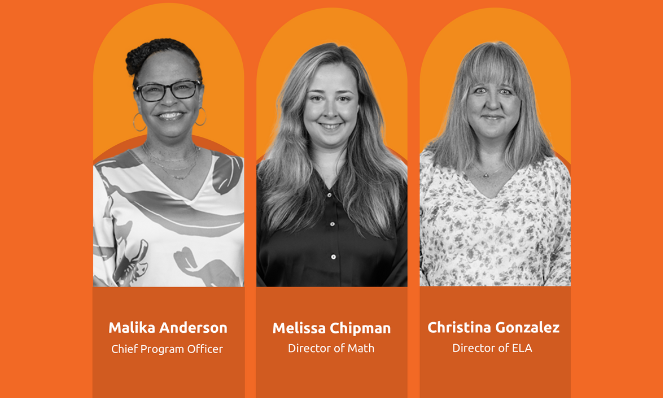
Q&A: How Leaders Can Support Grade-Level Learning
During a recent webinar, the Instruction Partners team answered questions about strategies for helping teachers and students stay on track with grade-level content.
These strategies can empower teachers to deliver grade-level instruction without sacrificing rigor or leaving out important content—ensuring that students have the knowledge and skills they need to succeed in their next grade level and beyond.
Once you discover that intervention is needed (during Tier 1 instruction), do you intervene with the use of grade-level materials?
Melissa Chipman, Director of Math: That depends on when and how you are approaching the intervention. The vast majority of Tier 1 instruction time should be focused on grade-level content, so if you are intervening during Tier 1 class time, you should be prioritizing grade-level content. An exception to this could be if you are doing a bridge task, mini lesson, or flex day, you may pull in some below grade-level content (if you have identified from data that it is needed). If you find yourself often needing a bridge task, mini lesson, or flex day, then you should consider revisiting the schedule to create dedicated time for Tier 2 and TIer 3 interventions because you do not want to risk losing too much of your essential grade-level instruction time.
Where can teachers find math activities to address unfinished learning during flexible time in a pacing guide?
Melissa Chipman, Director of Math: That’s always difficult, because you don’t want to spend an excessive amount of time looking for materials. I would not recommend searching on the internet, because you just cannot ensure the quality of those tasks. There are two places I would look for high-quality, standards-aligned tasks:
First and foremost, I recommend looking right inside of your curriculum. Most of the time, we will not get to every problem in every lesson, so going back to previous lessons is a great place to start. (And, even if you’ve done the task before, revisiting it will not cause any harm.)
Another great resource to leverage is the coherence map from Student Achievement Partners—that’s a reliable place to get a standards-aligned task. There is at least one task attached to most of the standards, and you can even use the map to determine what prerequisite knowledge might be a barrier for students.
What resources do you recommend for high school math content prioritization?
Melissa Chipman, Director of Math: High school is tricky because there is not as much out there about what the major content is for each grade level. This is partly due to the fact that the course progressions are not the same across schools. Student Achievement Partners put out a priority content guide for the 2020–21 school year that still has a lot of relevant guidance. It goes through all of the standards and marks which content to emphasize and which does not need to be prioritized. That’s a concrete tool that you can use for prioritization.
When I coached in a high school, a lot of this work required asking, “What are the biggest prerequisites for the course progressions that you have?” You need to be really clear on what the prerequisites are in each of your courses, which you can find in the Widely Applicable Prerequisites for College and Careers document from Student Achievement Partners. Once you know the load-bearing prerequisites, you can leverage that knowledge to make prioritization decisions.
How long does it take to create pacing guidance in ELA?
Christina Gonzalez, Director of ELA: This is a two-part process. First, you’ll need to complete a curriculum audit and determine what knowledge you want to prioritize for students. It’s been my experience that when you know the curriculum well—in other words, you’re not spending a lot of time figuring out how to navigate the curriculum and how to find all of the resources you need—it takes about an hour and a half per grade level to complete the audit and make decisions about what to teach. For example, you could say, “Module 4 does not add anything to our student learning this year, so we are actually going to omit the entire module. But, we have one standard in Module 4 that’s not taught anywhere else, so we need to shift it to another module.”
The second part of the process takes a bit longer. After deciding what content you are going to prioritize, you have to put into a pacing guide that is clear and usable for teachers. Again, if you know the curriculum well, it will take maybe two to two and a half hours per grade level.
Do we need to engage in the ELA and math prioritization processes every year, or just once?
Christina Gonzalez, Director of ELA: Once you have a really solid guide in place, then it’s only a one-time thing. You might need to do some adjustments based on teacher feedback, but you typically don’t need to make large-scale adjustments. The only likely reason you would completely change it is if you changed curricula.
How can content-based social studies help to address unfinished learning?
Malika Anderson, Chief Program Officer: I want to reflect on this quote: “The more you learn about the world, the larger your vocabulary gets. The more you know about the world and the more words you know, the better comprehension you demonstrate because of that knowledge” (Whipple 1925; NCES, 2012).
What is social studies if not learning about the world? There are absolutely ways to collaborate between and across subjects, leveraging all of the fantastic learning and knowledge-building that happens in social studies.
Do you have classroom management and resource suggestions for the fluency block? Often, I have a wide range of learners, and I’m always looking for meaningful work for my on-grade-level learners and those who need enrichment.
Christina Gonzalez, Director of ELA: There’s a great routine on the Student Achievement Partners’ website that you can apply to any text. My suggestion would be that you apply it to the text that’s actually under study in your classroom instead of trying to source other texts. The students can practice different excerpts from the text, depending on what their fluency needs are.
Can you elaborate on the specific skills students need to practice syntax mastery
Christina Gonzalez, Director of ELA: We don’t want to think about syntax practice as drilling grammar practice. The intention behind syntax practice is that we are helping students to understand how the syntax of a sentence contributes to the meaning of the sentence and to help students unpack really complicated syntax so that they can get to the meaning. It’s less about underlining nouns and verbs and more about understanding how the construction of the sentence contributes to the meaning of the sentence. One really common and popular tool to use to do that is a “juicy sentence” protocol. Dr. Lily Wong Fillmore has led this approach, particularly for multilingual learners, and Student Achievement Partners created a tool based on that work.
What are the best ways for state-level leaders to support accelerated learning efforts?
Malika Anderson, Chief Program Officer: There are two key ways I can see for state education agency (SEA) leaders to support educators and students with moving forward into grade-level learning. First, the SEA is in a fantastic position to use their bully pulpit to influence how instruction time is used. This could involve issuing encouraging guidance for districts to make sure that the vast majority of Tier 1 instruction time is dedicated to grade-level content. It could also involve an annual planning session with district leaders to share strategies and resources for supporting grade-level learning.
The second way to support accelerated learning is to use funding incentives. The allocation of funds by the SEA can make certain strategies more likely to be implemented at the district level. For example, this could look like using ESSER funds to incentivize content-specific and HQIM-aligned teacher professional learning to help ensure that Tier 1 instruction is taught more effectively.


